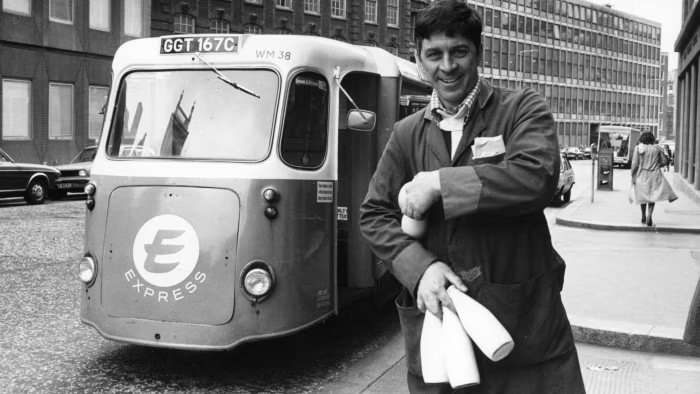You often hear them before you see them: the unmistakable clink and tinkle of glass bottles in crates, and the low whine of the electric motor. Milk floats are a uniquely British sight, and an increasingly rare one, which is why the British photographer and cultural historian Maxine Beuret has spent 20 years documenting their use by dairies across England, as part of her project Two Pints Please.
Beuret, who calls herself a historian of the commonplace, has documented several quirks of British culture that are at risk of disappearing (or have since gone), including slam-door commuter trains, TfL’s Routemaster buses before they were decommissioned, and traditional shops in the Midlands including a sweet shop, a men’s outfitters and a hardware store. She first photographed an electric milk float while undertaking another project called Familiar Interiors of Leicester – her hometown – in 2005. As well as creating a record of the library, the hospital, the pub and other cherished places, she visited the local dairy, Kirby & West, and “instantly fell in love” with the milk floats, she says. “I loved the compact, functional design, clean lines, and fragile sense of history they carried with them.”
It’s the floats themselves that interest Beuret – and the milkmen who drive them (as yet she hasn’t met a woman who delivers milk, though she’d love to hear from them). “I don’t go into the politics of the dairy industry or farmers,” she says. “I’m interested in the heritage of having milk delivered, and also the beauty of the design of the milk floats.”
Beuret visited several dairies, from the Sidcup arm of Milk & More (one of the largest corporate dairies in Britain) to Cotteswold (one of the biggest family-run independents). Some of the milkmen she joined on their rounds start their shifts in the middle of the night, heading to the depot to pick up their vehicle before covering 40 or 50 streets. Beuret loves the way the floats are “open; there’s no door between the cab and the goods at the back, or the street, so the milkman can easily hop off, grab bottles and chat to people. Like a dancer, they move almost unconsciously: waving, talking to customers and people on the street.”
She saw first-hand how the milkmen were at the heart of their communities. “They see children born, grow up and leave home.” Steve, who has been delivering for Parker Dairies in Woodford Green, east London, for more than 40 years, worked closely with Beuret on the project over several years. “He is an extrovert who has become friends with his customers,” she says. “He prefers to deliver midmorning rather than very early, and he encourages people to talk about their life.” As he puts it himself: “You know when they’re having a bad day, and they know when you’re having a bad day, and once you get to know them you can talk about it. And it always helps to talk.”
Steve has on more than one occasion closed a front door that had been mistakenly left open by a customer, and has twice called out the emergency services because he was concerned about his customers’ wellbeing. He has become a local treasure; since 2019 he has turned on Wanstead’s Christmas lights every year, playing festive music from his lit-up float.
How did electric milk floats come to be such a uniquely British thing? It’s mostly down to government intervention: the Milk Marketing Board for England and Wales was established under the Agricultural Marketing Acts of 1931 and 1933 to stabilise the price of milk. Milk floats were a regular sight from the 1930s to the 1990s, part of the fabric of daily life, with numbers reaching their peak in the 1970s, with more than 50,000 registered in Britain.
Now, Beuret estimates there are fewer than 400 electric floats used for milk deliveries in Britain – and no new ones are being made. In fact, the dairies barely have the mechanics to service existing models. Beuret met Bernard at Parker Dairies, who is training his grandson Huey to fix them like he does, and Bob who was at one point the sole mechanic for two dairies, one in Coventry and one in Cheshire. A year after she interviewed Andrew, a milkman for more than 29 years in Sidcup, his float was replaced with a light electric van. “They are disappearing before our eyes,” she says.
Supermarket milk in cartons and plastic bottles have long become the norm, with doorstep-delivered milk a niche service, though Covid lockdowns led to a brief boom – and increased eco awareness has brought a new audience, too. Then there are the families for whom it has always been the way to get milk; the elderly customers who pay with cheques and leave a note out with their empties.
“These dairies know they can’t compete with the supermarkets on price,” says Beuret, “but they can on service. The industry relies on loyalty. And that is part of the reason the milkmen are such visible characters in the community.” They build up their customer base by themselves: many of them have “bought their round”, securing the right to supply certain roads, and many have expanded the service to also offer orange juice, non-dairy drinks, bread and other essentials.









